 AMSTERDAM
AMSTERDAM 
 AMSTERDAM
AMSTERDAM 
We left from Newark Airport on Friday night and arrived at Schiphol
Airport, near Amsterdam, on Saturday. Schiphol has only one terminal,
but the place is clean, modern, efficient and very tourist-friendly.
From the airport, we took a train into the city.
The train took us to the Centraal Station in Amsterdam (at right) and
only took 20 minutes. All trains and trams start here in the Centraal
Station. How convenient
to have a train that goes to Amsterdam right at the airport terminal.
Another
thing about the trains in the Netherlands, they are very clean, very
cheap
and very on time (you know who liked that last part). A train
into
Amsterdam runs every 15 minutes. While we 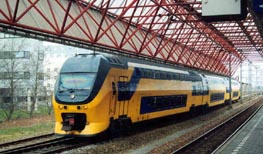 were in the airport, we
bought Amsterdam Passes for only €29 each.
This turned out to be a big bargain for us. Along with a three-day tram
pass, it had free admission to museums, canal rides and discounts on
many
other things. They use Euros here now
were in the airport, we
bought Amsterdam Passes for only €29 each.
This turned out to be a big bargain for us. Along with a three-day tram
pass, it had free admission to museums, canal rides and discounts on
many
other things. They use Euros here now
(€ is the symbol for
euros), the
Dutch Guilder has been
almost
completely replaced. Some places still give the price in both, but we
never
saw a guilder while we were there. The Euro dollar is worth around 90
cents (in 2002),
so it is pretty close to the American dollar. Once you arrive
at the
Centraal Station, you can take numerous, and many times colorful,
trams throughout the city (if you look closely you see the Mercedes
Benz logo on the front of the red tram). There is one tram ride that
goes around the
city and is good to see the sights.
around the
city and is good to see the sights.
We
were staying at the Inntel
Amsterdam Zaandam Hotel, which is in
Zaandam,
a city about 6 miles northwest of Amsterdam across the North Sea Canal,
about
10 minutes by train. The picture above-left is of one of the trains in
the
Zaandam
train station that we took into Amsterdam each day. After arriving at
the Centraal  Station, we had to
switch trains to Zaandam. We found the hotel easily enough; it is right
next
to the station. The room was very clean and pleasant. After a little
unpacking
we went back to the train station and bought tickets to back to
Amsterdam. The
tickets were cheap; a round-trip for the two of us was only € 6,60.
Station, we had to
switch trains to Zaandam. We found the hotel easily enough; it is right
next
to the station. The room was very clean and pleasant. After a little
unpacking
we went back to the train station and bought tickets to back to
Amsterdam. The
tickets were cheap; a round-trip for the two of us was only € 6,60.
The architecture of the Centraal Station is very interesting. This is the major train station in Amsterdam (a frontal picture is at the top of the webpage). The Neo-Renaissance red-brick railway station was designed by PJH Cuypers, who who designed the Rijksmuseum (National Museum), and was opened in 1889. The Dutch created three artificial islands, first driving 8,600 wooden piles into the water, to build the station on. It cuts off the view to the water, but makes an incredible entranceway to the city. 1,400 trains come through this station everyday. On the left is a picture of one of the two towers. It looks like a clock, but it's not. It's actually a weathervane (It's between the Z or zuiden and the O or oosten - so the wind is from the south-east). The west tower (left in top picture) has the weathervane and the east tower (right in top picture) has the clock.
Since this was
our first trip to Amsterdam, we decided to get acclimated to the city
by taking a canal boat ride. Amsterdam
is a city of canals. It has been called the "Venice of the North." The
sky
was beautiful, but it was a little cool and breezy so we took our
jackets.
They took a good picture of
us getting onto the canal boat in the Damrak (below). It was a one-hour
canal ride. The boat was glass enclosed so we
were warm,
almost
hot. We went clockwise around the city canals (at right). We didn't
know the city
very well, so we didn't know where we were. After we returned to the
Damrak, we
started
to walk around the city.
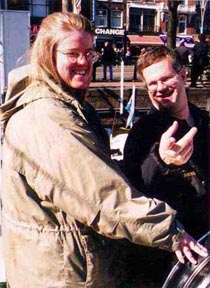 The next evening, we
would took another canal boat ride, however, this one was free because
of the Amsterdam Pass. It was getting dark so it was nice to travel on
the canal at twilight. Many of the canal bridges are lit up.
The next evening, we
would took another canal boat ride, however, this one was free because
of the Amsterdam Pass. It was getting dark so it was nice to travel on
the canal at twilight. Many of the canal bridges are lit up.
After our first canal trip, we
followed the tourists and headed to the Oude Zijde
(Old side) section of the city. We headed
to the Oude Kerk (Old Church) and quickly realized that we had
unknowingly
wandered into the Red Light District. The streets was full of glass
doors,
with red neon lights above them, with scantily dressed prostitutes
smiling
at the people passing by. At night, they would have black lights in
their
booths, which gave their white outfits (what little there was of them)
a glow in the dark effect. These booths extend around the Oude Kerk.
There
were sex shops and strange fountains, which even I couldn’t take a
picture
of.
 Flag of
Amsterdam: The three Xs -St. Andrew's crosses- represent the
three virtues of the city; Valor, Resolute and Merciful. A popular
tradition also links the X's to the three threats to the city, Water,
Fire and Pestilence. Flag of
Amsterdam: The three Xs -St. Andrew's crosses- represent the
three virtues of the city; Valor, Resolute and Merciful. A popular
tradition also links the X's to the three threats to the city, Water,
Fire and Pestilence. |
 sides, was built later in the
14th
century. It wasn't built all at once, but started as a small stone
church and was enlarged over the years. It has grown from a
single-aisled church into a large basilica. The large spire, which can
be
seen from all over Amsterdam, was finished in 1566. A few years later,
during the
Alteration in 1578 (when the Calvinist took over Amsterdam and kicked
the Catholics out), the paintings and statues were destroyed. Luckily
the ceilings and stained glass windows were not touched. A 47-bell
carillon was added in 1658. There is an incredible organ inside (if you
look closely at the picture, you can see the green 'Urinoir' on the
lower right-hand side).
sides, was built later in the
14th
century. It wasn't built all at once, but started as a small stone
church and was enlarged over the years. It has grown from a
single-aisled church into a large basilica. The large spire, which can
be
seen from all over Amsterdam, was finished in 1566. A few years later,
during the
Alteration in 1578 (when the Calvinist took over Amsterdam and kicked
the Catholics out), the paintings and statues were destroyed. Luckily
the ceilings and stained glass windows were not touched. A 47-bell
carillon was added in 1658. There is an incredible organ inside (if you
look closely at the picture, you can see the green 'Urinoir' on the
lower right-hand side). In the Dam and next to
the
Koninklijk Paleis is De Nieuwe Kerk
or "New Church." The Nieuwe Kerk was built in the late 14th century and
became Amsterdam's second church as the population of the city outgrew
the Oude Kerk. It was partly destroyed and rebuilt again after several
fires. During the Alteration in 1578, it was stripped of it's
valuables. In 1645, fire damaged everything but the facade and walls.
Vying
for importance with the Town Hall & Royal Palace, the Nieuwe Kerk
lost out in its rivalry with the Town Hall because it was denied a
tower by the city's magistrate. Inside the church, the pulpit is the
focal point, not the altar, due to the Protestant belief that the
sermon is more important then anything else. The pulpit, which is very
elaborate for a Dutch Protestant church, took 15 years to carve. What
appears to be the side of the church (photo at right) is actually the
main entrance.
In the Dam and next to
the
Koninklijk Paleis is De Nieuwe Kerk
or "New Church." The Nieuwe Kerk was built in the late 14th century and
became Amsterdam's second church as the population of the city outgrew
the Oude Kerk. It was partly destroyed and rebuilt again after several
fires. During the Alteration in 1578, it was stripped of it's
valuables. In 1645, fire damaged everything but the facade and walls.
Vying
for importance with the Town Hall & Royal Palace, the Nieuwe Kerk
lost out in its rivalry with the Town Hall because it was denied a
tower by the city's magistrate. Inside the church, the pulpit is the
focal point, not the altar, due to the Protestant belief that the
sermon is more important then anything else. The pulpit, which is very
elaborate for a Dutch Protestant church, took 15 years to carve. What
appears to be the side of the church (photo at right) is actually the
main entrance.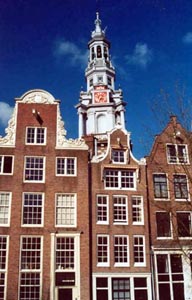 About two blocks south
of the Nieuwmarkt in the University District within the Old City
is De Zuiderkerk
or "Southern Church." This church was also designed by
Hendrick de Keyser. Construction started in 1603 and was completed in
1611. The Renaissance-style Zuiderkerk was the
first Calvinist church to open in Amsterdam after the Alteration. It is
a pseudo-basilica, six bays long, with Tuscan columns, timber barrel
vaults and dormers. The
white spire, red clock and onion dome are prominent landmarks in
Amsterdam. In 1929, the Zuiderkerk closed it's doors as a church. In
1988, it was
restored
About two blocks south
of the Nieuwmarkt in the University District within the Old City
is De Zuiderkerk
or "Southern Church." This church was also designed by
Hendrick de Keyser. Construction started in 1603 and was completed in
1611. The Renaissance-style Zuiderkerk was the
first Calvinist church to open in Amsterdam after the Alteration. It is
a pseudo-basilica, six bays long, with Tuscan columns, timber barrel
vaults and dormers. The
white spire, red clock and onion dome are prominent landmarks in
Amsterdam. In 1929, the Zuiderkerk closed it's doors as a church. In
1988, it was
restored  and re-opened as a public
housing exhibition center. You can
go inside and climb the tower here also, but again we didn't. They have
a carillon that plays on Sundays between 4 and 5 in the afternoon
(which you see in the picture at left). The
church here is partially hidden in the photo on the right by some canal
houses on
the Raamgracht.
and re-opened as a public
housing exhibition center. You can
go inside and climb the tower here also, but again we didn't. They have
a carillon that plays on Sundays between 4 and 5 in the afternoon
(which you see in the picture at left). The
church here is partially hidden in the photo on the right by some canal
houses on
the Raamgracht.  On the Western side of
Amsterdam is De Westerkerk or
"Western Church."
It has the Prince's
Canal (De
Prinsengracht) in
front of it and the Emperor’s Canal (De Keizergracht) behind it with open
space on either side of it. The church has the tallest tower in
Amsterdam at 272 feet high, topped by the Imperial Crown of Maximilian
of Austria, and the longest nave of any Dutch Protestant church. The
Westerkerk was designed by Hendrick de Keyser, who died in 1621, a year
after work began. It was completed in 1631. The hour bell is
the heaviest in Amsterdam and weighs more than 7 tons. There
is also a carillon of 50 bells. The photo was taken from across the
Keizergracht.
On the Western side of
Amsterdam is De Westerkerk or
"Western Church."
It has the Prince's
Canal (De
Prinsengracht) in
front of it and the Emperor’s Canal (De Keizergracht) behind it with open
space on either side of it. The church has the tallest tower in
Amsterdam at 272 feet high, topped by the Imperial Crown of Maximilian
of Austria, and the longest nave of any Dutch Protestant church. The
Westerkerk was designed by Hendrick de Keyser, who died in 1621, a year
after work began. It was completed in 1631. The hour bell is
the heaviest in Amsterdam and weighs more than 7 tons. There
is also a carillon of 50 bells. The photo was taken from across the
Keizergracht. On March
10, 1966, Princess
Beatrix and German diplomat Claus von Amsberg were
married in the
Westerkerk. Queen Beatrix became the Queen of The Netherlands in
1980 for those who didn't know they still had a monarchy
(her husband, Prince Claus, passed away in 2002). The Queen lives in
Noordeinde Palace in The Hague.
On March
10, 1966, Princess
Beatrix and German diplomat Claus von Amsberg were
married in the
Westerkerk. Queen Beatrix became the Queen of The Netherlands in
1980 for those who didn't know they still had a monarchy
(her husband, Prince Claus, passed away in 2002). The Queen lives in
Noordeinde Palace in The Hague. De Krijtberg started out as a
hidden church in the early 17th century and took the recently canonized
Jesuit Francis Xavier as their patron. The protestant city council knew
about the more than fifteen hidden Catholic churches, but as long as
money was paid they would let the Catholics have their churches. When
the Catholics obtained religious freedom in the 19th century they built
a new church. The current church, squeezed between small canal houses
along the Singelgracht, is a tall
twin-steepled Neo-Gothic building constructed in 1884. In side the
church there are statues to St. Francis Xavier and St. Ignatius are
either side of the high altar. In the 1970's, as Catholic attendance
dropped, the Krijtberg was going to be demolished but was saved by
parishioners who raised enough money for the churches renovation which
was still going on when we were there. The photo of the church is from
the Spui Plaza across the Singel.
De Krijtberg started out as a
hidden church in the early 17th century and took the recently canonized
Jesuit Francis Xavier as their patron. The protestant city council knew
about the more than fifteen hidden Catholic churches, but as long as
money was paid they would let the Catholics have their churches. When
the Catholics obtained religious freedom in the 19th century they built
a new church. The current church, squeezed between small canal houses
along the Singelgracht, is a tall
twin-steepled Neo-Gothic building constructed in 1884. In side the
church there are statues to St. Francis Xavier and St. Ignatius are
either side of the high altar. In the 1970's, as Catholic attendance
dropped, the Krijtberg was going to be demolished but was saved by
parishioners who raised enough money for the churches renovation which
was still going on when we were there. The photo of the church is from
the Spui Plaza across the Singel.|
A Short History of Amsterdam
 Amsterdam was founded as a fishing village around the thirteenth
century. In 1264, a dam was built on the river Amstel, hence its
original name Amstelredam,
dam on the river Amstel. 11 years later, Floris V, the Count of
Holland, grants Amstelredam freedom from tolls when crossing his land.
In 1296, Floris, who had become fairly powerful, was murdered by his
rival, Lord Gijsbrecht van Amstel IV (this would result in the downfall
and exile of the van Amstel family).
Amsterdam was founded as a fishing village around the thirteenth
century. In 1264, a dam was built on the river Amstel, hence its
original name Amstelredam,
dam on the river Amstel. 11 years later, Floris V, the Count of
Holland, grants Amstelredam freedom from tolls when crossing his land.
In 1296, Floris, who had become fairly powerful, was murdered by his
rival, Lord Gijsbrecht van Amstel IV (this would result in the downfall
and exile of the van Amstel family). The early "Amsterdammers" acquired a talent for trade and from the fourteenth century onwards trade with the Hanseatic cities flourished. Medieval Amsterdam's chief exports were herring and beer. It was during this time that early forms of canal houses started to appear. Amsterdam gained city rights in 1301, granted by Guy van Henegouwen, the Bishop of Utrecht, but this was only a confirmation of the earlier rights given to the city by the Lords of Aemstel. Amsterdam suffers two devastating fires in the 15th century and by 1480 built a defensive wall around the city (after the second fire, which destroyed three-fourths of the city) the city passed a law against using wood for buildings). In 1482, control of the Netherlands goes to future Holy Roman Emperor, Maximilian. In 1506, the Netherlands passes under the rule of Charles (who will later become the king of Spain and then the Holy Roman Emperor). By this time, the population of Amsterdam reaches 12,000 and it had become the main power in the province of Holland. Anabaptists (Protestants) demonstrate in Dam Square in 1535 which leads to mass executions and 40 years of religious turmoil. The Edict of Blood in 1550 decreed death for all Protestants. In 1555, Charles V abdicates and King Philip II of Spain (the one who married Queen Mary of England and later sent the Spanish Armada to invade England) becomes ruler of the Netherlands. By this time, the population of Amsterdam reaches 30,000. As the Protestant Reformation swept through Northern Europe, Calvinism started to grow in power in the Netherlands. As a counter-measure, Philip II sent the Duke of Alva, nicknamed the Iron Duke, to the Netherlands with an army to suppress the Protestants. The Dutch resented Spanish taxes and feared the methods of the Spanish Inquisition. This resentment fueled Dutch protests about their rights, liberties and religious toleration upon which their wealth from free trade depended.  By the
late 16th century, the Dutch War of Independence, under Protestant
William of Orange (great-grandfather of King William III of England who
would be assassinated in the town of Delft in 1584), began against the
Spanish which would develop into the 80 Years' War.
Although originally on the Spanish side, Amsterdam switched sides in
1578. The Calvinists kicked out the Catholics in what has been called
"The Alteration."
However, freedom of religion was re-instated, a very positive
move at the time. Despite the attempts by the Calvinists, Amsterdam
remained a Roman Catholic
city, and Roman Catholicism remains the major religion in the city to
this day.
By the
late 16th century, the Dutch War of Independence, under Protestant
William of Orange (great-grandfather of King William III of England who
would be assassinated in the town of Delft in 1584), began against the
Spanish which would develop into the 80 Years' War.
Although originally on the Spanish side, Amsterdam switched sides in
1578. The Calvinists kicked out the Catholics in what has been called
"The Alteration."
However, freedom of religion was re-instated, a very positive
move at the time. Despite the attempts by the Calvinists, Amsterdam
remained a Roman Catholic
city, and Roman Catholicism remains the major religion in the city to
this day. With the help of Queen Elizabeth of England, the Netherlands, led by William's son, Maurice, was able to become free of Spanish rule by 1604. However, as religious wars continued to rage throughout Europe, many people were looking for a place of refuge where they would not be condemned for their religion. Wealthy Jewish families from Spain and Portugal, prosperous merchants from Antwerp, fleeing the destruction and ransacking of their city by the Spanish and the Huguenots from France all sought refuge in Amsterdam.  At the end of the 16th century, Amsterdam experiences a Golden Age
(1585-1672). Some of the most important historic buildings date back
to this period, like the town hall in the Dam Square (now the Royal
Palace), the Westerkerk, Zuiderkerk as well as a large number of canal
houses. In 1613, Amsterdam started work on it's triple rings of large
canals, bordered by beautiful houses, around the city. With this, the
city expanded as Amsterdam became the most important
port in the
world
and an international center for banking. Amsterdam's ships sailed to
North America, Indonesia, Brazil and Africa, building an impressive
empire in the process. A
Dutch settlement in the Americas was called, "New Amsterdam" (modern
New York City). The Dutch navy would fight the British and the French
for control of the seas. Amsterdam
also saw a growth in the arts. Famous painter Rembrandt van Rijn
(at left) lived and worked in Amsterdam.
At the end of the 16th century, Amsterdam experiences a Golden Age
(1585-1672). Some of the most important historic buildings date back
to this period, like the town hall in the Dam Square (now the Royal
Palace), the Westerkerk, Zuiderkerk as well as a large number of canal
houses. In 1613, Amsterdam started work on it's triple rings of large
canals, bordered by beautiful houses, around the city. With this, the
city expanded as Amsterdam became the most important
port in the
world
and an international center for banking. Amsterdam's ships sailed to
North America, Indonesia, Brazil and Africa, building an impressive
empire in the process. A
Dutch settlement in the Americas was called, "New Amsterdam" (modern
New York City). The Dutch navy would fight the British and the French
for control of the seas. Amsterdam
also saw a growth in the arts. Famous painter Rembrandt van Rijn
(at left) lived and worked in Amsterdam.The 18th and 19th century saw a decline in the prosperity of Amsterdam (though they did remain wealthy). Wars against England and France eventually took their toll on the city and trade was lost to London. Nevertheless, Amsterdam managed to consolidate its prosperity from 1672 to 1795, despite the predicament the Republic was in. Amsterdam remained a major staple market and managed to retain its position as the financial center of Europe. However, in 1795 the government of the patrician oligarchies was overthrown and the old Republic ceased to exist. Soon the French, under Napoleon, occupied the country. From 1795 to 1813, Amsterdam suffered badly from the economic recession, reflected by the stagnation of the city. Many houses were vacant and some even collapsed for lack of maintenance. At the end of the 19th century, the Industrial Revolution reached Amsterdam. New waterways to the sea and to the river Rhine river improved communication with the rest of Europe and the world. Amsterdam got a new lease on life, but never reached the same supremacy as before. Amsterdam started to develop the area beyond the Singelgracht. World War I did not affect Amsterdam as the Netherlands remained neutral, although trade and industry suffered. Between the wars, the Dutch built a dike separating the Zuider Zee from the North Sea, thus creating the Ijsselmeer. Because of this, rivers flow into the Ijsselmeer, so the waters to the east of Amsterdam are no longer salt water, but fresh water that can be used for drinking. 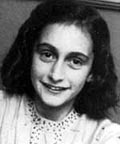 During World War II, German troops occupied the city on May 15, 1940.
During the Nazi occupation, about 100,000 Jewish people were deported
from Amsterdam to concentration camps, almost
completely wiping out the Jewish community in the city. Anne Frank
(at right) and her family were among those people deported. Before the
war,
Amsterdam was the world's
center for the diamond trade. Since this trade was mostly in the hands
of Jewish businessmen and craftsmen, the diamond trade almost
disappeared. Amsterdam is still important, but the city of Antwerp in
Belgium is the main center for diamonds today. By September of 1944,
the people of Amsterdam hoped for liberation, as the German armies were
on the run after their defeat in Normandy and Allied troops had crossed
into Holland. However, the Allies defeat at Arnhem (depicted in the
movie A Bridge
Too Far) forced the people of Amsterdam to endure a harsh winter
of depravation. The Germans held on to the Netherlands as the Allies
bypassed them and pushed into Germany. It wasn't until May 7, 1945,
(two weeks after Hitler's suicide) that Canadian troops entered
Amsterdam liberating it from the Nazi's.
During World War II, German troops occupied the city on May 15, 1940.
During the Nazi occupation, about 100,000 Jewish people were deported
from Amsterdam to concentration camps, almost
completely wiping out the Jewish community in the city. Anne Frank
(at right) and her family were among those people deported. Before the
war,
Amsterdam was the world's
center for the diamond trade. Since this trade was mostly in the hands
of Jewish businessmen and craftsmen, the diamond trade almost
disappeared. Amsterdam is still important, but the city of Antwerp in
Belgium is the main center for diamonds today. By September of 1944,
the people of Amsterdam hoped for liberation, as the German armies were
on the run after their defeat in Normandy and Allied troops had crossed
into Holland. However, the Allies defeat at Arnhem (depicted in the
movie A Bridge
Too Far) forced the people of Amsterdam to endure a harsh winter
of depravation. The Germans held on to the Netherlands as the Allies
bypassed them and pushed into Germany. It wasn't until May 7, 1945,
(two weeks after Hitler's suicide) that Canadian troops entered
Amsterdam liberating it from the Nazi's.The sixties and seventies put Amsterdam back on the map, for reasons other than trade. The tolerance of soft drugs made the city a popular destination for hippies, and the squatting of unoccupied buildings became widespread. Riots and clashes with the police were frequent. In 1980, while Queen Beatrix was crowned the new Queen of The Netherlands in the Nieuwe Kerk on Dam square, a group of protesters outside fought against the police. Today, Amsterdam is the largest city in The Netherlands with 800,000 people. Although the seat of government is at Den Haag (The Hague), Amsterdam is still the nominal capital. It is situated on low-lying ground at the confluence of the Amstel and the Ij rivers near the Ijsselmeer. Amsterdam, like much of Holland, is below sea level. |
 |
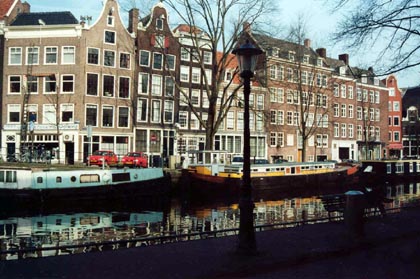 |
| De PRINSENGRACHT (The Prince's Canal) Now, that's careful parking! |
OUDEZIJDS VOORBURGWAL (Looking toward St. Nicolaasserk) |
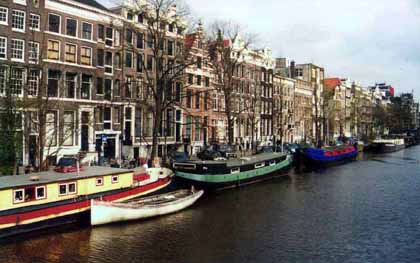 |
 |
| De PRINSENGRACHT (The Prince's Canal) | De BROUWERSGRACHT (The Brewers Canal) |
 |
 |
| OUDEZIJDS VOORBURGWAL (Looking toward St. Nicolaasserk) The shape of the canal house at right gives a strange illusion |
De KEIZERSGRACHT (The Emperor's Canal) |
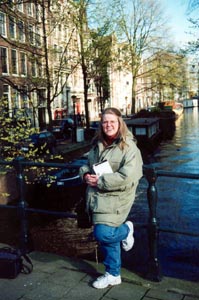 a canal, especially in the Oude
Zijde
section. Four major canals ring the
city (gracht is the Dutch word for canal).
They are, extending out in order, the Gentleman’s Canal (De
Herengracht),
the Emperor’s Canal (De Keizergracht), the Prince’s Canal (De
Prinsengracht - photo above)
and the Singel.
The Gentleman’s Canal is considered one of the prettiest. Almost every
canal is full of house boats (there is a big housing
shortage
in Amsterdam). There are
also numerous smaller canals, of which the Brouwersgracht (The Brewers
Canal - photo above) named
after the many breweries that use to line the canal, the
Bloemgracht (the Flower Canal), the Leliegracht and the Raamgracht near
the Zuiderkerk (the first Calvinist Church in
Amsterdam) are especially pleasant.
a canal, especially in the Oude
Zijde
section. Four major canals ring the
city (gracht is the Dutch word for canal).
They are, extending out in order, the Gentleman’s Canal (De
Herengracht),
the Emperor’s Canal (De Keizergracht), the Prince’s Canal (De
Prinsengracht - photo above)
and the Singel.
The Gentleman’s Canal is considered one of the prettiest. Almost every
canal is full of house boats (there is a big housing
shortage
in Amsterdam). There are
also numerous smaller canals, of which the Brouwersgracht (The Brewers
Canal - photo above) named
after the many breweries that use to line the canal, the
Bloemgracht (the Flower Canal), the Leliegracht and the Raamgracht near
the Zuiderkerk (the first Calvinist Church in
Amsterdam) are especially pleasant. 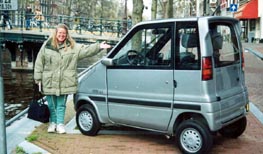 Its fun to walk around the city, but you have to be
careful. They have
about a billion or so bicycles going in the city. The streets are
narrow,
so you have to be careful not to be run over by bicycles, cars or
trams. Driving a car seems totally out of the question. The streets are
very narrow and their is very little parking. However, some
Amsterdammers do own and drive cars. Though as you can see from this
picture, some of the cars can be quite small. You can also see in
the picture that there is not much of a railing between the road and
the canal (here it is about four inches high) so it wouldn't take much
to accidentally drive into a canal. We were told that it does happen on
occasion.
Its fun to walk around the city, but you have to be
careful. They have
about a billion or so bicycles going in the city. The streets are
narrow,
so you have to be careful not to be run over by bicycles, cars or
trams. Driving a car seems totally out of the question. The streets are
very narrow and their is very little parking. However, some
Amsterdammers do own and drive cars. Though as you can see from this
picture, some of the cars can be quite small. You can also see in
the picture that there is not much of a railing between the road and
the canal (here it is about four inches high) so it wouldn't take much
to accidentally drive into a canal. We were told that it does happen on
occasion.  The Netherlands is known for its unique architecture, and that
architecture is best exemplified in its
The Netherlands is known for its unique architecture, and that
architecture is best exemplified in its  canal houses. In a country
where land is precious people squeeze themselves into every available
space. Most of these buildings are less than 30-feet wide (you were
taxed on the width of your home's facade) with three large windows. To
make up for this shortfall, the Dutch learned to build up, and use
steep narrow staircases to maximize space efficiency. Since you can't
get furniture up those stairs, many of the houses are built to
protrude, or lean over the street they face. At the top is a beam with
a pulley so that large objects can be lifted in through the windows.
The Dutch brought that space-saving sensibility with them to the New
World when they founded New Amsterdam, which became New
York. Large parts of New York City still have three- and four-story
canal houses. In a country
where land is precious people squeeze themselves into every available
space. Most of these buildings are less than 30-feet wide (you were
taxed on the width of your home's facade) with three large windows. To
make up for this shortfall, the Dutch learned to build up, and use
steep narrow staircases to maximize space efficiency. Since you can't
get furniture up those stairs, many of the houses are built to
protrude, or lean over the street they face. At the top is a beam with
a pulley so that large objects can be lifted in through the windows.
The Dutch brought that space-saving sensibility with them to the New
World when they founded New Amsterdam, which became New
York. Large parts of New York City still have three- and four-story "brownstones" stacked next to each other like canal houses in their
fatherland.
"brownstones" stacked next to each other like canal houses in their
fatherland. 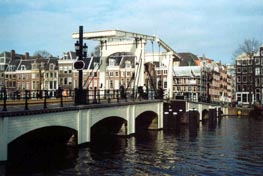 Not too far from the Willet-Holthuysen Museum and the Rembrandtplein is
the Magere Brug
(bridge) over the Amstel River between the Keizersgracht and the
Prinsengracht.
Of Amsterdam's 1,280 or so bridges, the Magere Brug, or “Skinny Bridge”
is the most famous. It is a traditional double-leaf, Dutch draw-bridge
connecting the banks of the river Amstel. Approximately every twenty
minutes, the bridge opens to let boats through. The original bridge was
built in 1670 and was said to be so narrow that two people couldn't
pass each other. As the traffic on Amstel increased, a wider bridge
was built in 1871 to replace the old narrow one. At night, it is all
lit up
with lights.
Not too far from the Willet-Holthuysen Museum and the Rembrandtplein is
the Magere Brug
(bridge) over the Amstel River between the Keizersgracht and the
Prinsengracht.
Of Amsterdam's 1,280 or so bridges, the Magere Brug, or “Skinny Bridge”
is the most famous. It is a traditional double-leaf, Dutch draw-bridge
connecting the banks of the river Amstel. Approximately every twenty
minutes, the bridge opens to let boats through. The original bridge was
built in 1670 and was said to be so narrow that two people couldn't
pass each other. As the traffic on Amstel increased, a wider bridge
was built in 1871 to replace the old narrow one. At night, it is all
lit up
with lights. |
Amsterdam Sports
 Like most places in the world, football (or soccer in America) is the
top sport in Amsterdam. The main professional club is
Amsterdamsche Football Club Ajax or AFC
Ajax. The club is
historically one of the top-10 football clubs in the world,
and one of the three clubs that dominate Dutch football, the other two
being Feyenoord Rotterdam and PSV Eindhoven. AFC Ajax is one of only
four clubs to have won all three major European
trophies at least once (the European Champions Cup, the European Cup
Winners Cup and the UEFA Cup). They play in the KNVB or Koninklijke
Nederlandse Voetbal Bond (Royal Dutch Football Association). They are
the most successful team in the league winning 29 titles (as of 2005).
They wear white jerseys with a large
horizontal bar down the front. They go by the nicknames "Godenzonen"
(Sons of gods) or "Joden" (Jews). They play in the 51,859 seat Amsterdam
ArenA which opened in 1996. The arena is also the home of the
American
football tear, Amsterdam
Admirals. They even have an American fansite called Ajax USA.
Like most places in the world, football (or soccer in America) is the
top sport in Amsterdam. The main professional club is
Amsterdamsche Football Club Ajax or AFC
Ajax. The club is
historically one of the top-10 football clubs in the world,
and one of the three clubs that dominate Dutch football, the other two
being Feyenoord Rotterdam and PSV Eindhoven. AFC Ajax is one of only
four clubs to have won all three major European
trophies at least once (the European Champions Cup, the European Cup
Winners Cup and the UEFA Cup). They play in the KNVB or Koninklijke
Nederlandse Voetbal Bond (Royal Dutch Football Association). They are
the most successful team in the league winning 29 titles (as of 2005).
They wear white jerseys with a large
horizontal bar down the front. They go by the nicknames "Godenzonen"
(Sons of gods) or "Joden" (Jews). They play in the 51,859 seat Amsterdam
ArenA which opened in 1996. The arena is also the home of the
American
football tear, Amsterdam
Admirals. They even have an American fansite called Ajax USA. The club was founded in Amsterdam in 1900 in a bar on Kalverstraat. For a name, The founders chose a notorious and bold Greek warrior: Ajax. In 1934, Ajax moved to De Meer Stadion in east Amsterdam, where they would play until 1996. De Meer stadium was an unusually small stadium for such a large club, but the small stadium also created a cozy atmosphere. De Meer was demolished to make way for a housing development after Ajax moved to a new stadium in 1996 (sounds like Ebbetts Field). Football season in the Netherlands runs from the beginning of August and ends at the beginning of May. There are 20 teams in the league. The team with the best record is considered the champion. Ajax has accomplished this 29 times. Three Dutch teams then get to compete in the UEFA Champions League (a prestigious championship of the most successful football clubs in Europe which was inaugurated in 1955). The KNVB championship team automatically goes while 2nd place plays 5th place and 3rd place plays 4th place, with the two winners going. In 1957, Ajax qualified for their first European Cup (for-runner of the current UEFA Champions League), winning two games before being eliminated by Vasas SC of Budapest 4-0. They returned again in 1960-61 but were eliminated early by Fredrikstad FK of Norway. The late sixties saw a real emergence from Ajax. They qualified for the European Cup in 1966-67 losing in the quarter-finals to Dukla Prague. The following year, they lost in the 1st Round to powerhouse Real Madrid. In 1968-69, Ajax advanced all the way to the European Cup finals but lost to AC Milan 4-1 in Santiago Bernabéu in Madrid. Two years later during the early 1970's, AFC Ajax dominated European club football by winning the European Cup in 1971, 1972 and 1973 (they defeated Panathinaikos FC of Greece 2-0, FC Internazionale of Milan 2-0 and Juventus FC of Turin 1-0). The success had two main causes: the highly disciplined coaching by Rinus Michels (who developed the concept of Total Football or "Totaal Voelbal") and the genius of Johan Cruijff (often spelled Cruyff outside the Netherlands). Ajax string of championships ended in 1973-74 when they lost 2-0 to CSKA Sofia. Between 1978 and 1986, Ajax qualified for the European Cup five times. In 1995, after a nine year absence, they returned to the UEFA Champions League (they renamed it in 1992) and advanced all the way to the finals. In Ernst Happel Stadium in Vienna, they defeated AC Milan 1-0 on a goal by Patrick Kluivert late in the game for their fourth championship. The following year, AFC Ajax again advanced to the finals only to lose in penalty kicks to Juventus FC of Turin. They qualified again in 1998-99. Ajax has qualified every year since 2001-02 (6 straight times) for a total of 23 times. In 2003, they advanced to the semi-finals before losing 3-2 to eventual winner AC Milan. In 2006-07, they lost in the Third Qualifying Round to F.C. Copenhagen. The Ajax fans have the very remarkable tradition of using Jewish and Israeli symbols to express their allegiance. Regularly, the supporters wave large Star of David flags and scream Joden! Joden! ("Jews! Jews!") to fire up their team. Die-hard Ajax supporters call themselves "F-Siders" or "Joden" -- Dutch for "Jews" -- a nickname that reflects the team's and Amsterdam's Jewish roots. The nickname for Ajax fans dates back to before World War II, when Amsterdam was home to many of the Netherlands' 140,000 Jews and the Ajax stadium was located near a Jewish neighborhood. Most Dutch Jews were killed in the Holocaust, and little remains of Amsterdam's old Jewish quarter. But the tradition survived. Ajax currently has no Jewish players, the last player with Jewish roots being Daniel de Ridder. |
 On
Sunday, it was sunny with some clouds out, but still cool. We explored
almost the entire city by foot. Just a five-minute walk down the
Damrak from Centraal Station takes you into this jam-packed square,
full of locals and tourists day and night, called The Dam. It was
created in the 13th
century when a dam was built across the river Amstel to prevent the
Zuiderzee sea from flooding the city (the photo looks up the Damrak
toward the Centraal Station in the distance). During the sixties, the
square
was renowned for its Dam Square hippies, and the laid back and relaxed
character of this densely pigeon populated square lives on.
On
Sunday, it was sunny with some clouds out, but still cool. We explored
almost the entire city by foot. Just a five-minute walk down the
Damrak from Centraal Station takes you into this jam-packed square,
full of locals and tourists day and night, called The Dam. It was
created in the 13th
century when a dam was built across the river Amstel to prevent the
Zuiderzee sea from flooding the city (the photo looks up the Damrak
toward the Centraal Station in the distance). During the sixties, the
square
was renowned for its Dam Square hippies, and the laid back and relaxed
character of this densely pigeon populated square lives on.  Dam Square is the Koninklijk Paleis and the
Nieuwe Kerk. In the east side of the
square is the National Memorial, an obelisk flanked by two lion
statues, erected in memory of
Dutch soldiers and members of the resistance who died in World War II
(at right).
In the north part of the square, next to the Damrak, there is a 15th
century wall statue to Sint Nicolaas (St. Nicholas) on one of the
buildings (left). Sint Nicolaas is the patron saint of sailors
and is thus important
Dam Square is the Koninklijk Paleis and the
Nieuwe Kerk. In the east side of the
square is the National Memorial, an obelisk flanked by two lion
statues, erected in memory of
Dutch soldiers and members of the resistance who died in World War II
(at right).
In the north part of the square, next to the Damrak, there is a 15th
century wall statue to Sint Nicolaas (St. Nicholas) on one of the
buildings (left). Sint Nicolaas is the patron saint of sailors
and is thus important  to Amsterdam. December 5th is the
principal Dutch
day of giving presents called Sinterklaasavond so he is also called
Sinter Claes (sounds familiar). Madame Tussaunds museum is on the
south side of the square. Around the square, there are food stalls,
restaurants and shops, so we
stopped at one for breakfast.
to Amsterdam. December 5th is the
principal Dutch
day of giving presents called Sinterklaasavond so he is also called
Sinter Claes (sounds familiar). Madame Tussaunds museum is on the
south side of the square. Around the square, there are food stalls,
restaurants and shops, so we
stopped at one for breakfast. The Koninklijk
Paleis (Royal Palace) in the west end of the square was
originally built as the the Stadhuis (town hall) of Amsterdam (the
Nieuwe Kerk is just to the right in the photo). They started building
it in at the end of the 80 Years' War in 1648 with Spain. Workers had
to drive 13,600 wooden piles into the ground for
support. Designed by
Jacob van Campen, it reflects Amsterdam's feeling of confidence after
beating the Spanish and enjoying her Golden Age. Inside there is a
large hall with maps of the eastern and western hemispheres inlaid in
the marble floor. When Napoleon occupied the Netherlands, he had his
brother Louis Napoleon declared the emperor of the Netherlands in 1808.
Louis took the palace as his royal residence. After the French left,
it became the Royal Palace. Although it
is no longer home to the Dutch Royal family, the palace is still used
to hold official receptions.
The Koninklijk
Paleis (Royal Palace) in the west end of the square was
originally built as the the Stadhuis (town hall) of Amsterdam (the
Nieuwe Kerk is just to the right in the photo). They started building
it in at the end of the 80 Years' War in 1648 with Spain. Workers had
to drive 13,600 wooden piles into the ground for
support. Designed by
Jacob van Campen, it reflects Amsterdam's feeling of confidence after
beating the Spanish and enjoying her Golden Age. Inside there is a
large hall with maps of the eastern and western hemispheres inlaid in
the marble floor. When Napoleon occupied the Netherlands, he had his
brother Louis Napoleon declared the emperor of the Netherlands in 1808.
Louis took the palace as his royal residence. After the French left,
it became the Royal Palace. Although it
is no longer home to the Dutch Royal family, the palace is still used
to hold official receptions.  One of the more popular plaza in Amsterdam is the
Leidseplein. This square is one of the
liveliest squares in the city and a
busy
tram intersection. The square developed in the 17th century as a wagon
park for farmers and peasants to leave their carts here before entering
the city center. The name comes from the Leidsepoort, which once marked
the end of the main road from Amsterdam to Leiden. On our first day
here, we stopped for a
beer (bier) and a soda at the
Heineken
Cafe. You can probably guess who had what. We came back here on
Tuesday,
after spending the morning in the Rijksmuseum Museum, for lunch and a
couple of Heineken weissbiers (for me of course).
One of the more popular plaza in Amsterdam is the
Leidseplein. This square is one of the
liveliest squares in the city and a
busy
tram intersection. The square developed in the 17th century as a wagon
park for farmers and peasants to leave their carts here before entering
the city center. The name comes from the Leidsepoort, which once marked
the end of the main road from Amsterdam to Leiden. On our first day
here, we stopped for a
beer (bier) and a soda at the
Heineken
Cafe. You can probably guess who had what. We came back here on
Tuesday,
after spending the morning in the Rijksmuseum Museum, for lunch and a
couple of Heineken weissbiers (for me of course).
The people in Amsterdam are very friendly and almost everyone speaks English fluently. The days were cool, but people still sat outside at the cafes. Unfortunately, it became a bit colder at night, so not many braved the temperatures to sit outside. Late Monday afternoon, after visiting the Van Gogh Museum, we came back here to have coffee and hot chocolate in an English Pub. This time we sat inside.
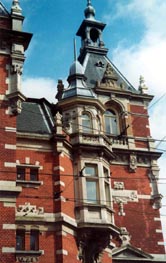 Around the Leidseplein is the Stadsschouwburg (at right).
It is a red bricked Neo-Renaissance theater that was built in the last
century. Up until 1986, it was home to the Dutch national ballet
and opera companies. Today it stages plays by local drama groups. When
Amsterdam's top soccer team, Ajax, wins important games, crowds crowd
in the Leidseplein to cheer for the team members who gather on the
theater's balcony. Ajax plays in the Dutch Football League (remember
their football is our soccer) and has won 29 championships along with
four European Cups and two World Club Championships.
Around the Leidseplein is the Stadsschouwburg (at right).
It is a red bricked Neo-Renaissance theater that was built in the last
century. Up until 1986, it was home to the Dutch national ballet
and opera companies. Today it stages plays by local drama groups. When
Amsterdam's top soccer team, Ajax, wins important games, crowds crowd
in the Leidseplein to cheer for the team members who gather on the
theater's balcony. Ajax plays in the Dutch Football League (remember
their football is our soccer) and has won 29 championships along with
four European Cups and two World Club Championships.
The American Hotel is also here. The original hotel, with
it's American motif, complete with bronze eagle and wooden indians, was
torn down in 1901. The current Art Nouveau style hotel was built the
following year. Inside is the Cafe Americain, an Art Deco style
restaurant, where Debbie and I had dinner one night. When you leave the
Leidseplein, you can walk along the busy Leidsestraat, across the main
canals, back toward the center of the Amsterdam like we did one night.
Rembrandtplein
 One day, after visiting the Anne Frank
Haus, we had lunch at an outdoor
café in the
Rembrandtplein (Rembrandt
plaza). It's between the Amstel River and the
Herengracht across from the Old City. It was originally called the
Botermarkt, after the butter market held here until the mid-19th
century. In the center of
the plaza is a park
with, you guessed it, Rembrandt's statue. It was erected here in 1876,
giving the square it's new name.
One day, after visiting the Anne Frank
Haus, we had lunch at an outdoor
café in the
Rembrandtplein (Rembrandt
plaza). It's between the Amstel River and the
Herengracht across from the Old City. It was originally called the
Botermarkt, after the butter market held here until the mid-19th
century. In the center of
the plaza is a park
with, you guessed it, Rembrandt's statue. It was erected here in 1876,
giving the square it's new name.
The Rembrandtplein is a very colorful square lined
with
pubs, restaurants,
cafes and hotels and is thus a tourist magnet (as can be seen in the
photo at left). At night, when all of
the
neon 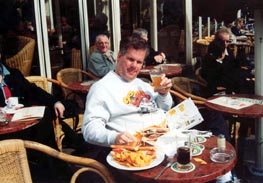 advertising
signs are on, it becomes even more colorful. A popular
center for
nightlife, it also includes traditional Dutch pubs which play real
Dutch music and serve Dutch beer. Our lunch at an outdoor cafe
was very enjoyable as was my Amstel bier (I was impressed that Amstel made a
draft weissbier which is my favorite). Local musicians play for you as
you eat and drink and then pass around the hat for a Euro or two. When
we were there, there was a bagpiper playing for us. It didn't seem
traditionally Dutch, but it was fine.
advertising
signs are on, it becomes even more colorful. A popular
center for
nightlife, it also includes traditional Dutch pubs which play real
Dutch music and serve Dutch beer. Our lunch at an outdoor cafe
was very enjoyable as was my Amstel bier (I was impressed that Amstel made a
draft weissbier which is my favorite). Local musicians play for you as
you eat and drink and then pass around the hat for a Euro or two. When
we were there, there was a bagpiper playing for us. It didn't seem
traditionally Dutch, but it was fine.
Waterlooplein
 In the Old City, not to far from the Nieuwmarkt, is
Waterlooplein. This square dates from 1882, when two canals were filled
in to create a large market square in the Jewish quarter. The area
originally called Vlooyenberg, a place built in the 17th century to
house incoming Jewish settlers. The square now takes it's name from the
famous 1815 battle that ended Napoleon's bid to re-conquer Europe.
In the Old City, not to far from the Nieuwmarkt, is
Waterlooplein. This square dates from 1882, when two canals were filled
in to create a large market square in the Jewish quarter. The area
originally called Vlooyenberg, a place built in the 17th century to
house incoming Jewish settlers. The square now takes it's name from the
famous 1815 battle that ended Napoleon's bid to re-conquer Europe.
Debbie and I went to the Rembrandt House Museum. After walking through Rembrandt's house we went to the “Experience Holland” next door. It's a 28-minute light and 3-D movie on the Netherlands called “Experience Holland.” It was all right. Afterwards, we walked over to the Waterlooplein which also has a large open flea-market that sells everything and anything. We walked through it, but didn't buy anything. Next to the bridge over the Zwanenburgwal across from Rembrandt's House, is this interesting canal house with a bar and outdoor cafe that appears to be tipping over.
Begijnhof
Not to
far from the Spui plaza is the Begijnhof. This is not a traditional
square with cafes and restaurants but an enclosed courtyard
dating from the early 14th century. Nothing survived of the earliest
dwellings, but the Begijnhof, which is cut off from Amsterdam's traffic
noise by houses, still retains a sanctified atmosphere. We had to walk
through an arched entrance to see it. The Begijnhof
was originally built as a sanctuary for the Begijntjes, a Catholic
sisterhood who lived like nuns, although they took no monastic vows.
The beautiful houses overlook its well-kept green garden, include the
Amsterdam's oldest surviving house, the Het Houten Huis. It dates from
around 1420. On the adjoining walls, there is a fascinating collection
of wall plaques with biblical theme. Southern fringe of the square is
dominated by the Engelse Kerk (English Church) which dates from the
15th century and possesses its original medieval tower. Originally a
Catholic Church, it was confiscated during the Alteration and then
rented to a group of English and Scottish Presbyterians in 1607. We
were
told
that some of the original Pilgrims may have worshipped here while they
were living in Amsterdam before coming to America
on the Mayflower to establish the Plymouth Colony in 1620. We wanted to
go inside, but there was a wedding going on.
|
Beers of Amsterdam
 Some of
the most famous beers in the world come from Amsterdam. The most famous
of them all is Heineken. In 1863, 22-year old Gerard Adriaan Heineken
bought a 16th century brewery and started brewing his famous beer. He
was shocked by the
drunkenness in Amsterdam caused by gin drinking that he wanted to
brew a healthy beer. Today, Heineken is the second largest
producer of beer (over 2.5 billion gallons). It is also the largest
exporter, shipping a half
Some of
the most famous beers in the world come from Amsterdam. The most famous
of them all is Heineken. In 1863, 22-year old Gerard Adriaan Heineken
bought a 16th century brewery and started brewing his famous beer. He
was shocked by the
drunkenness in Amsterdam caused by gin drinking that he wanted to
brew a healthy beer. Today, Heineken is the second largest
producer of beer (over 2.5 billion gallons). It is also the largest
exporter, shipping a half billion gallons of beer a year, in their famous green bottles, around the world.  Another
famous beer started a few years later. In 1870, Baron C. A. de Pester
began a brewery next to the river in Amsterdam which gives it's beer
it's name, Amstel. Today, Amstel is the second largest exporter
of beer in the world. In America, it's Amstel Light is the number one
imported light beer. However, Amstel makes ten different kinds of beer.
In 1968, the two beer companies, Heineken and Amstel, who were bitter
rivals, decided to join forces and merge.
Another
famous beer started a few years later. In 1870, Baron C. A. de Pester
began a brewery next to the river in Amsterdam which gives it's beer
it's name, Amstel. Today, Amstel is the second largest exporter
of beer in the world. In America, it's Amstel Light is the number one
imported light beer. However, Amstel makes ten different kinds of beer.
In 1968, the two beer companies, Heineken and Amstel, who were bitter
rivals, decided to join forces and merge.Amsterdam also makes some other good beers like Wieckse Witte and De Koninck. Another famous Dutch beer, though not from Amsterdam, is Grolsch which has it's origins going back to the 17th century. |
AMSTERDAM'S
MUSEUMS
 On
Monday, we visited the Anne
Frank House. This is the building that Anne Frank and her family
hid for over two years from the Nazi's during World War II and she
wrote
her diary. They hid in the annex of the building at Prinsengracht 263
(facing the Prince’s canal) where
Anne’s father, Otto Frank, also had
his business. The Van Pels family and Fritz Pfeffer hid there with
them. The doorway to the back annex was concealed behind a moveable
bookcase
constructed especially for this purpose. The office personnel knew of
the hiding place and helped the eight people by supplying them with
food and news of the outside world. On August 4, 1944, the hiding place
was discovered. The people in hiding were arrested by the Gestapo (Nazi
secret police) and deported to various
concentration camps. Only Otto Frank survived the war.
On
Monday, we visited the Anne
Frank House. This is the building that Anne Frank and her family
hid for over two years from the Nazi's during World War II and she
wrote
her diary. They hid in the annex of the building at Prinsengracht 263
(facing the Prince’s canal) where
Anne’s father, Otto Frank, also had
his business. The Van Pels family and Fritz Pfeffer hid there with
them. The doorway to the back annex was concealed behind a moveable
bookcase
constructed especially for this purpose. The office personnel knew of
the hiding place and helped the eight people by supplying them with
food and news of the outside world. On August 4, 1944, the hiding place
was discovered. The people in hiding were arrested by the Gestapo (Nazi
secret police) and deported to various
concentration camps. Only Otto Frank survived the war.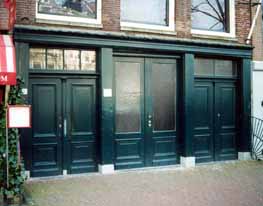 Today the house is
a museum. We walked past it on Sunday and saw the long lines so we
decided to go early on Monday. There was a line, but it wasn’t bad, it
cost only € 6,50 each. You see a few videos in a larger modern building
next door. Then you walk through the front part of the building
(below), which
had offices and a warehouse. You see Mr. Frank's office. After that,
you go though the secret annex past the swinging bookcase
in the back of the building. All of the
rooms are the same as they were in 1944 when Anne Frank, her family and
the other Jewish people hid for 28 months from the Nazi’s. The rooms
are empty now except for Anne’s pictures that she pasted to the walls
of her room (where she wrote most of her diary); all of the furniture
is gone because the Nazi’s confiscated it after the families were
arrested. In the multimedia space, visitors can go on a “virtual
journey” through the Anne Frank House, accessing background information
about the people in hiding and World War II. The museum gets very busy
and the lines can get long. That's why we went first thing in the day. After this we walked around the nearby
Westerkerk and then headed
across the city to
the Rembrandtplein (Rembrandt plaza) for lunch.
Today the house is
a museum. We walked past it on Sunday and saw the long lines so we
decided to go early on Monday. There was a line, but it wasn’t bad, it
cost only € 6,50 each. You see a few videos in a larger modern building
next door. Then you walk through the front part of the building
(below), which
had offices and a warehouse. You see Mr. Frank's office. After that,
you go though the secret annex past the swinging bookcase
in the back of the building. All of the
rooms are the same as they were in 1944 when Anne Frank, her family and
the other Jewish people hid for 28 months from the Nazi’s. The rooms
are empty now except for Anne’s pictures that she pasted to the walls
of her room (where she wrote most of her diary); all of the furniture
is gone because the Nazi’s confiscated it after the families were
arrested. In the multimedia space, visitors can go on a “virtual
journey” through the Anne Frank House, accessing background information
about the people in hiding and World War II. The museum gets very busy
and the lines can get long. That's why we went first thing in the day. After this we walked around the nearby
Westerkerk and then headed
across the city to
the Rembrandtplein (Rembrandt plaza) for lunch.
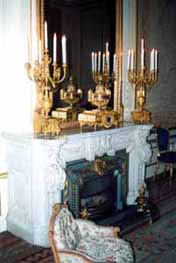 A short
distance from Rembrandtplein is the
Willet-Holthuysen
Museum on
Herengracht facing the canal. It's a large 17th century
canal
house owned by a rich Amsterdam merchant named Pieter Holthuysen and
then
his daughter and son-in-law, Abraham Willet. Today it is furnished in
the
luxury style of 18th and 19th century merchants (Oh boy, is it ever!).
These people knew how to live. Some of the rooms remain unchanged,
while others, such as the kitchen and the Garden room, have been
restored in the style of the 18th century.
A short
distance from Rembrandtplein is the
Willet-Holthuysen
Museum on
Herengracht facing the canal. It's a large 17th century
canal
house owned by a rich Amsterdam merchant named Pieter Holthuysen and
then
his daughter and son-in-law, Abraham Willet. Today it is furnished in
the
luxury style of 18th and 19th century merchants (Oh boy, is it ever!).
These people knew how to live. Some of the rooms remain unchanged,
while others, such as the kitchen and the Garden room, have been
restored in the style of the 18th century.
The
picture here is of one of the fireplaces in the museum. As you can see
Holthuysen's and the Willet's lived in style. You should see their
bedroom! All of the rooms are set up as if the families are going to
come home at any minute.
Later on Monday, we
took a tram to the Van Gogh
Museum
in the Museum District
between the Rijksmuseum and the Stedelijk
Museum. The Van Gogh Museum entrance is on the Paulus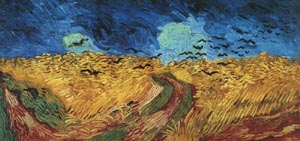 Potterstraat. The
museum has a very interesting architectural design and contains the
largest collection of van Gogh's paintings in the world. There was a
small line. We paid the € 26 for
the two of us to go in, which I thought was quite expensive. Van Gogh's
work is organized chronologically into five periods, each representing
a different phase of his life and work: The Netherlands, Paris, Arles,
Saint-Remy and Auvers-sur-Oise. They also had a
special exhibit, Van Gogh & Gauguin. We saw a lot of
Potterstraat. The
museum has a very interesting architectural design and contains the
largest collection of van Gogh's paintings in the world. There was a
small line. We paid the € 26 for
the two of us to go in, which I thought was quite expensive. Van Gogh's
work is organized chronologically into five periods, each representing
a different phase of his life and work: The Netherlands, Paris, Arles,
Saint-Remy and Auvers-sur-Oise. They also had a
special exhibit, Van Gogh & Gauguin. We saw a lot of  Sunflower
paintings
and one of his last works, Crows in the Wheatfield
(above - we bought a copy of this print which is now hanging in our
living room
at home). They had a recreation of Van Gogh's studio. We spent about an
hour
in there. We bought some prints in the gift shop. They put them in
these
long blue triangular shaped boxes that scream "tourist". We had seen
many
people walking around the city with these same boxes. Now we joined
them.
The picture at left is a wall mural of one of Debbie's favorite
paintings, Van Gogh's Starry Night on one of the streets
in Amsterdam.
Sunflower
paintings
and one of his last works, Crows in the Wheatfield
(above - we bought a copy of this print which is now hanging in our
living room
at home). They had a recreation of Van Gogh's studio. We spent about an
hour
in there. We bought some prints in the gift shop. They put them in
these
long blue triangular shaped boxes that scream "tourist". We had seen
many
people walking around the city with these same boxes. Now we joined
them.
The picture at left is a wall mural of one of Debbie's favorite
paintings, Van Gogh's Starry Night on one of the streets
in Amsterdam.
On Tuesday it was cloudy so I didn’t take too many
pictures. We took the
tram
to the Rijksmuseum. 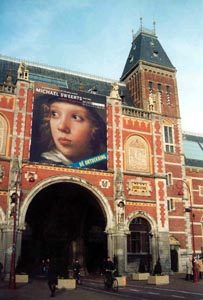 Amsterdam's Rijksmuseum,
the National Museum, is the largest museum of art and history in the
Netherlands. It was opened in 1800 as the Nationale Konstgallerij
(National Art Gallery). After moving from place to place, Architect
P.J.H. Cuypers designed this historical building using a mixture
of Gothic and Renaissance styles. It was officially opened in 1885. The
building is very large and historical and receives
over a million visitors a year. The cost
was
€ 8,- each, but we got in free because of the Amsterdam Pass. We first
went through the wing with the furniture and dishes. They do have a
couple
of interesting Dollhouses. We went into a special exhibit on the 17th
Century
Dutch painter, Michail Sweerts. From there, we went to the main hall
also called the Night Watch Hall,
which
features the museums main attraction, Rembrandt’s The Night Watch
(below).
If you visit the Rijksmuseum, come to the main hall first. Other works
exhibited
numerous
Dutch painters like Vermeer, Frans Hals and Jan Steen. Also, there is a
part on Dutch history. We got to the museum at 10:15 and left at 2:30.
We spent over 4 hours inside! If you go here, go to the main hall
first. By the time we got there, we were a bit tired.
Amsterdam's Rijksmuseum,
the National Museum, is the largest museum of art and history in the
Netherlands. It was opened in 1800 as the Nationale Konstgallerij
(National Art Gallery). After moving from place to place, Architect
P.J.H. Cuypers designed this historical building using a mixture
of Gothic and Renaissance styles. It was officially opened in 1885. The
building is very large and historical and receives
over a million visitors a year. The cost
was
€ 8,- each, but we got in free because of the Amsterdam Pass. We first
went through the wing with the furniture and dishes. They do have a
couple
of interesting Dollhouses. We went into a special exhibit on the 17th
Century
Dutch painter, Michail Sweerts. From there, we went to the main hall
also called the Night Watch Hall,
which
features the museums main attraction, Rembrandt’s The Night Watch
(below).
If you visit the Rijksmuseum, come to the main hall first. Other works
exhibited
numerous
Dutch painters like Vermeer, Frans Hals and Jan Steen. Also, there is a
part on Dutch history. We got to the museum at 10:15 and left at 2:30.
We spent over 4 hours inside! If you go here, go to the main hall
first. By the time we got there, we were a bit tired.
The Night Watch, the most famous painting in
the Rijksmuseum, actually
has another title, Company
of Frans Banning Cocq and Willem van
Ruytenburch. Rembrandt painted it in 1642. The painting includes
eighteen actual militiamen (also called Arquebusiers) who all paid
Rembrandt to be in the painting (except the drummer who  was put in the painting for free)
making it a kind of team picture. The captain, Frans Banning Cocq is
wearing the red sash and is giving orders to his lieutenant, Willem van
Ruytenburch, who is dressed in gold. Some of the other people were
added to make the painting more interesting. What makes this painting
so different was it wasn't the typical group portrait with everyone
sitting around a table or posing in rows but rather the people in it
are in motion walking toward the viewer. It looks like a snapshot of a
group in action rather than a posed portrait.
was put in the painting for free)
making it a kind of team picture. The captain, Frans Banning Cocq is
wearing the red sash and is giving orders to his lieutenant, Willem van
Ruytenburch, who is dressed in gold. Some of the other people were
added to make the painting more interesting. What makes this painting
so different was it wasn't the typical group portrait with everyone
sitting around a table or posing in rows but rather the people in it
are in motion walking toward the viewer. It looks like a snapshot of a
group in action rather than a posed portrait.
At
almost 12 feet high and over 14 feet wide, it was a lot bigger then I
thought it would be (above right is only a portion of the actual
painting). Incredibly, the painting was originally bigger then it is
today. When it was moved from it's original location, the Great Hall of
the Arquebusiers, in 1715 to the Town Hall on the Dam Square (now the
Royal Palace), it was
too big to fit on the wall. The 'brilliant' solution they came up with
was to trim off parts of the paintings from all of the sides. A
particularly large piece was cut off the left side. Unfortunately none
of these pieces were kept. Three of the original militiamen in the
painting were thus removed (I guess they may be entitled to a refund).
It was moved to the Rijksmuseum in 1815 and finally to this building in
1885. It has only been moved once since then and that was to a
protective bunker during World War II.
A small
historical note; Frans Banning Cocq (in black with red sash) was born
in 1605 and, eight years after Rembrandt painted him, became the mayor
of Amsterdam. He died in 1655 and is buried in the tombs beneath the
Oude Kerk (though they don't know exactly where - opps, lost another
one).
 from 1639 until 1660. He lived on
the ground floor with his wife
Saskia, who died here in 1642. Rembrandt continued to live here
with his son Titus. Many of his famous works were painted in his first
floor studio while he taught students in the attic. The tour takes you
through the room where he worked in
and
his bedroom, his bed was interesting.
from 1639 until 1660. He lived on
the ground floor with his wife
Saskia, who died here in 1642. Rembrandt continued to live here
with his son Titus. Many of his famous works were painted in his first
floor studio while he taught students in the attic. The tour takes you
through the room where he worked in
and
his bedroom, his bed was interesting. 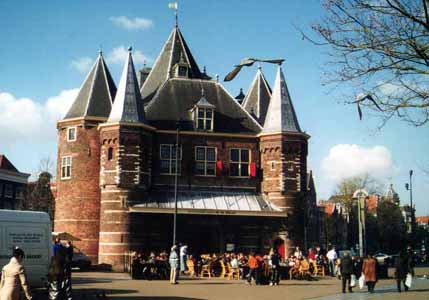 On Sunday night, after our twilight canal trip, we
went for dinner in De Waag.
The Waag is a
multi-turreted building in
the
middle of Nieuwmarkt square. It was built in 1488 as part of
Amsterdam’s defense
system. It still looks like a castle today. They used to have public
executions here in the square and kept
the condemned prisoners in the "little gallows room". Later they had an
anatomy theater there so surgeons could dissect people. Today is it a
very
nice restaurant that is lit with over 300 candles burning inside, most
of them in
large
chandeliers giving the place an incredible atmosphere. Dinner was very
good, as was the wine (a Californian cabernet). Just think, we travel
to
The Netherlands and order an American wine. I really liked the desert,
a creme
boulet with raspberry ice cream. Debbie had a chocolate (of course)
tart
with mango sauce. Overall, dinner was great and only cost € 94,10 which
is not bad considering it’s one of the more expensive restaurants in
the city. After dinner, we walked back through the Red Light District
and those friendly natives, to the Centraal Station to get our train
back to the hotel.
On Sunday night, after our twilight canal trip, we
went for dinner in De Waag.
The Waag is a
multi-turreted building in
the
middle of Nieuwmarkt square. It was built in 1488 as part of
Amsterdam’s defense
system. It still looks like a castle today. They used to have public
executions here in the square and kept
the condemned prisoners in the "little gallows room". Later they had an
anatomy theater there so surgeons could dissect people. Today is it a
very
nice restaurant that is lit with over 300 candles burning inside, most
of them in
large
chandeliers giving the place an incredible atmosphere. Dinner was very
good, as was the wine (a Californian cabernet). Just think, we travel
to
The Netherlands and order an American wine. I really liked the desert,
a creme
boulet with raspberry ice cream. Debbie had a chocolate (of course)
tart
with mango sauce. Overall, dinner was great and only cost € 94,10 which
is not bad considering it’s one of the more expensive restaurants in
the city. After dinner, we walked back through the Red Light District
and those friendly natives, to the Centraal Station to get our train
back to the hotel. On Monday night, we
walked to the Leidseplein
and had dinner in the Café
Americain,
which is in the American Hotel. The Café Americain is decorated
in art deco and is very comfortable. We had our best meal here. Debbie
had duck and I had pork with mushrooms and spinach. We had a good
French Beaujolais to go with it. Dessert, although it took forever to
arrive, was incredible. Debbie had a white chocolate mousse (Debbie
thinks white chocolate is sacrilegious) and I had a banana and honey
tart. If you come to Amsterdam, you must visit this place. The
service is not fast, but the food is certainly worth the wait. From
there, we decided to walk all the way back to the
Centraal
Station (to walk off desert). The picture at right is of the sign in
the
Leidseplein giving directions.
On Monday night, we
walked to the Leidseplein
and had dinner in the Café
Americain,
which is in the American Hotel. The Café Americain is decorated
in art deco and is very comfortable. We had our best meal here. Debbie
had duck and I had pork with mushrooms and spinach. We had a good
French Beaujolais to go with it. Dessert, although it took forever to
arrive, was incredible. Debbie had a white chocolate mousse (Debbie
thinks white chocolate is sacrilegious) and I had a banana and honey
tart. If you come to Amsterdam, you must visit this place. The
service is not fast, but the food is certainly worth the wait. From
there, we decided to walk all the way back to the
Centraal
Station (to walk off desert). The picture at right is of the sign in
the
Leidseplein giving directions. On
Tuesday, our last night, we looked at a
number of restaurants until
we found one on
Spuistraat
(a street off of the Spui plaza) called Haesje Claes. It was a little
touristy,
but it had a nice atmosphere. It had an old look with wooden walls and
candles. Dinner was good and so was the wine (a ’99 Chateau Le Payeal –
Bergerac), but we skipped dessert. Dinner was
only € 59,90. We skipped desert not to save money (or calories), but to
walk back to
The
Waag for their dessert. This time I tried the coffee ice cream with
white
chocolate
topping and Debbie had the same as the first time we were there (a
chocolate
tart with mango sauce). My dessert was good, but not as good as the
creme
boulet that I had there on Sunday.
On
Tuesday, our last night, we looked at a
number of restaurants until
we found one on
Spuistraat
(a street off of the Spui plaza) called Haesje Claes. It was a little
touristy,
but it had a nice atmosphere. It had an old look with wooden walls and
candles. Dinner was good and so was the wine (a ’99 Chateau Le Payeal –
Bergerac), but we skipped dessert. Dinner was
only € 59,90. We skipped desert not to save money (or calories), but to
walk back to
The
Waag for their dessert. This time I tried the coffee ice cream with
white
chocolate
topping and Debbie had the same as the first time we were there (a
chocolate
tart with mango sauce). My dessert was good, but not as good as the
creme
boulet that I had there on Sunday.